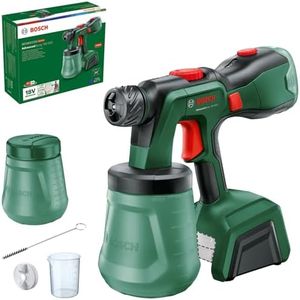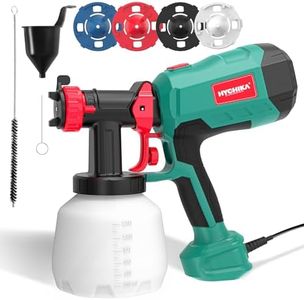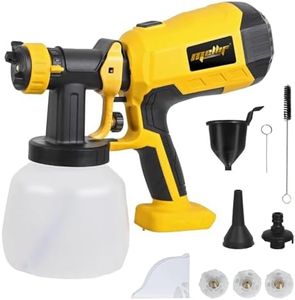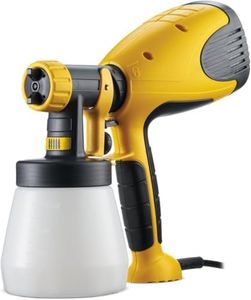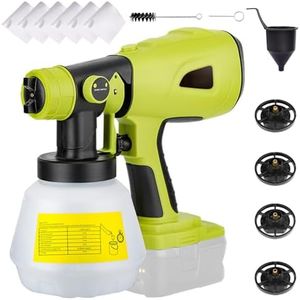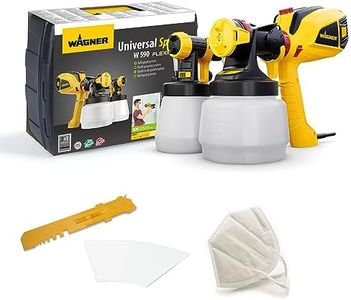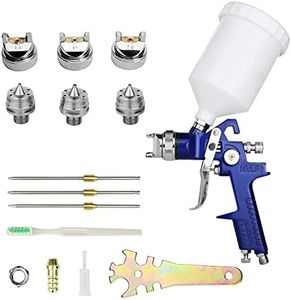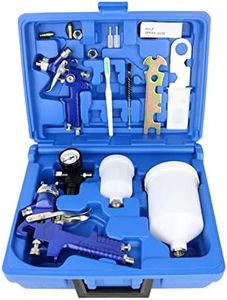We Use CookiesWe use cookies to enhance the security, performance,
functionality and for analytical and promotional activities. By continuing to browse this site you
are agreeing to our privacy policy
10 Best Hvlp Paint Sprayers
From leading brands and best sellers available on the web.By clicking on a link to a third party's website, log data is shared with that third party.
Buying Guide for the Best Hvlp Paint Sprayers
When looking to buy an HVLP (High Volume Low Pressure) paint sprayer, it's important to understand that your ideal choice will depend on the types of projects you plan to tackle, how often you'll use it, and your comfort level with handling paint equipment. HVLP sprayers are designed for less overspray and greater precision, making them popular for furniture, cabinetry, detailed work, and even some walls or fences. Choosing the right HVLP paint sprayer involves comparing a few key specifications that affect performance, convenience, and how well the sprayer will match your specific painting needs.Spray Pattern AdjustabilitySpray pattern adjustability refers to the ability of the paint sprayer to change the shape and size of the spray, such as round, horizontal, or vertical patterns. This is important because different projects require different spray widths and shapes for efficiency and a smooth finish. Many basic models offer at least two pattern options, while more advanced ones can fine-tune the pattern further. If you expect to work on projects with varied surfaces, such as detailed furniture and large panels, a sprayer with good pattern adjustability will make your work both easier and neater.
Nozzle SizeThe nozzle size dictates the type and thickness of material the HVLP sprayer can handle, measured in millimeters. Smaller nozzles (around 1.0-1.5 mm) are best for thin materials like stains or lacquers, while larger nozzles (up to 2.5 mm or more) can handle thicker paints like latex or enamel. It's important to match nozzle size to your primary painting materials—if you mostly spray thin finishes (like on cabinets), a smaller nozzle is better, but for general wall paint, you'll want a larger one. Some sprayers come with multiple changeable nozzles for flexibility.
Air Flow and Pressure ControlAir flow and pressure control refers to how much and how quickly the air moves through the sprayer, influencing both the speed of application and the finish quality. Fine control is important to reduce overspray and get a smoother finish, especially on detailed or delicate projects. Basic models might offer a single setting, while others allow you to dial in specific air pressure levels. If you're a beginner or working mostly on simple projects, less adjustability may suffice; advanced users or those painting a wide range of surfaces will benefit from more precise controls.
Paint Cup CapacityPaint cup capacity is the amount of paint the sprayer can hold at one time, usually measured in ounces or milliliters. Smaller cups (under 1 quart or 1 liter) are lighter and easier to maneuver, making them good for detailed work or touch-ups, but they require more frequent refilling. Larger cups are better for big projects like fences or doors but might be heavier and less precise for small items. Consider the typical size of your projects—choose a capacity that balances your need for mobility and convenience.
Portability and WeightPortability and weight describe how comfortable the sprayer is to carry and use, especially during longer sessions. Lightweight, handheld models offer greater control and are less tiring for shorter tasks or intricate work, while larger, stationary models with hoses might be better for covering broad surfaces quickly. Think about how long you'll typically hold the sprayer and if you'll need to move around a lot, as ease of handling can make a big difference in both your results and your comfort.
Ease of CleaningEase of cleaning is about how simple it is to take apart, wash, and reassemble the sprayer after use. Paint can dry and clog the device if not cleaned promptly, so a model with few parts and clear, accessible pathways will save you time and hassles. Some sprayers have special features like quick-release nozzles or include cleaning brushes. If you plan to change colors or materials frequently, or just want a stress-free maintenance routine, prioritize a sprayer that’s user-friendly when it comes to cleaning.

